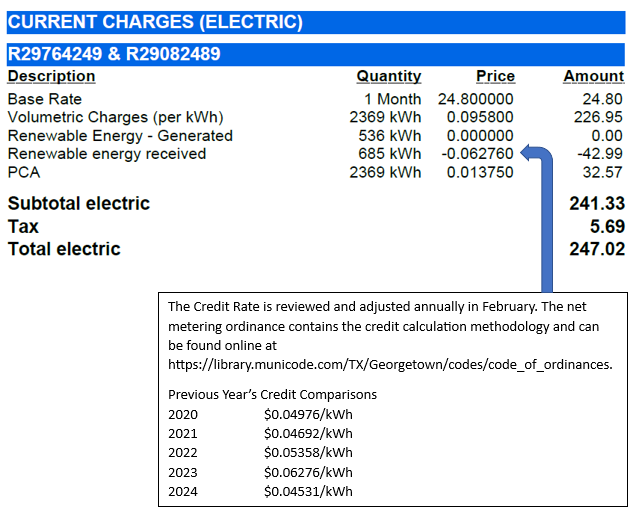Net Energy Metering
What is Net Energy Metering?
Net energy metering rate program allows residential and small commercial customers with
DER systems less than 10kW-DC and interconnection agreement to sell the excess energy
generated by their DER system (in excess of their consumption) at the rate identified in the
program.
Note: this graphic is for illustration and information purposes only
When a customer generates less energy than they consume, the Utility provides electricity to
the customer and the bi-directional meter measures that amount as volumetric energy.
Conversely, when the customer generates more energy than they consume, the excess
energy (received energy) is sent back to the Utility and the bi-directional meter measures
that amount as received energy. At the end of each billing period, the Utility uses the
volumetric and received energy measurement readings from the meter to calculate the
customer’s bill.
The current renewable energy received credit rate for eligible customers is $0.06276/kWh.
This credit rate is reviewed and adjusted annually in February of each year. Customers in
good standing on the net metering program rate as of October 1, 2020 will continue to
receive a credit of $0.09580 per kWh until September 30, 2022. Please see the graphic
above to see how your bill is calculated.
Most DER systems monitor the energy produced by your system. You can then reference the
reported amount from your system and compare it to your bill. See the bill calculation image
above for further assistance.
Currently, there are no surcharges once the system is operational.
The maximum amount of energy that can be sold to Georgetown cannot be greater than the
volumetric energy delivered to the customer.
Link to this site to project billing: http://pvwatts.nrel.gov/
At this time, there are not any rebates for installation of DER systems to the customer from the City. Confer with your installer for any further information.
Once a work order has been issued when interconnection is approved, it will take anywhere from 5-10 business days for the new meter to be installed and for your billing to begin reflecting the net meter changes.
- Please review the Net Energy Metering bill calculation to ensure you fully understand the credit for excess energy. The Net Energy Metering ordinance is can also be accessed here.
- Contact your installer if your system is not producing the estimated energy
- If there are any further questions regarding billing, please contact Customer Care at customercare@georgetown.orgor at 512-930-3640.
You can possibly offset all of the volumetric charges on your bill. Keep in mind that there are base and PCA charges that can’t be offset. Please see the Net Energy Metering ordinance here for more information. Please note that the amount of energy that can be sold back cannot be greater than the energy supplied by the Utility.
Annual Credit Rate Frequently Asked Questions
A cost-of-service rate study was completed in 2020 by consultants NewGen Strategies and Solutions. They recommended rates and rate structures that equitably funded the operations of the electric utility and removed any cross subsidies that existed. Modifications specific to the existing Net Energy Metering (NEM) Policy were adopted to incorporate industry best practices and clarify and simplify the NEM process.
Annual Review:
The Renewable Energy – Received Credit is updated annually. The updated credit is adopted for customer billing no later than March 31st.
Terms:
Renewable Energy – Received: Any excess metered energy generated from the customer’s DER facility that is not used on-site at the customer’s premises and flows back to COG during a billing cycle. The Renewable Energy — Received is measured by the bi-directional meter and recorded on an interval basis. COG pays NEM customers a credit per kilowatt hour of the Renewable Energy – Received
Renewable Energy – Received Credit: The Renewable Energy – Received Credit is an energy rate ($/kWh) applied to the NEM customer’s Renewable Energy – Received. COG pays NEM customers a credit per kilowatt hour for Renewable Energy – Received. The credit on the customer’s bill is subject to the limitations discussed in the ordinance section Item I.
Customers with Installed solar:
Current rate: $0.06276 per kWh
Mar 2024: $0.04531 per kWh
Solar customers are notified via letter of the annual Renewable Energy – Received Credit Rate. Last year’s letter was sent January 31, 2023.
The provisions of the credit are established in the Electric Rate Ordinance. View the Electric Rate Ordinance.
Yes, it is. Review the ordinance on the City’s website.










